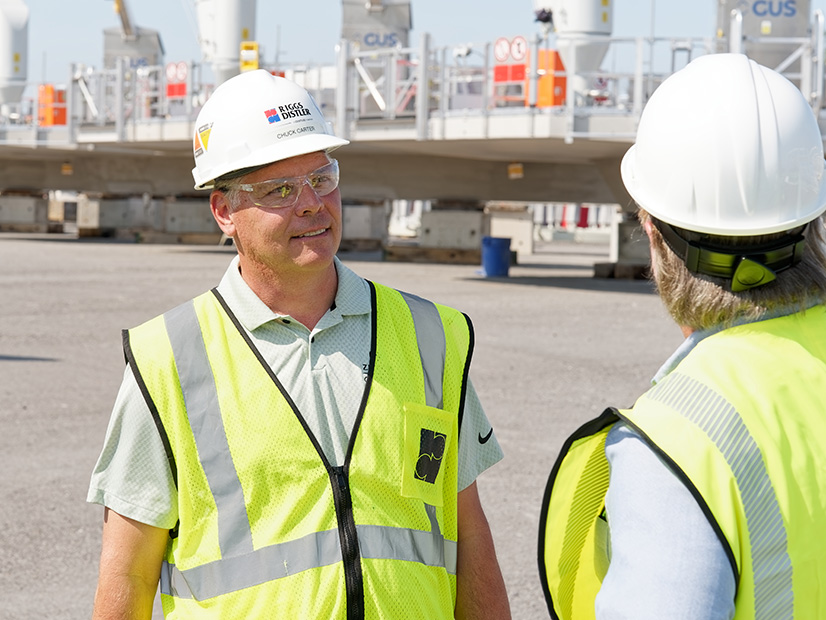FERC still is working to implement the changes to its generator interconnection rules from Order 2023, but it also is considering further changes, as it held a two-day workshop Sept. 10-11 to gather more input.
Order 2023 made improvements, FERC Chair Willie Phillips said at the start of the event, but it was not meant to be a silver bullet to queues that are seeing massive interest from new resources and overlapping with widespread demand growth.
“Our country has a severe interconnection queue backlog. We have over 2,000 GW of generation that’s waiting in the wings to be connected,” Phillips said. “We know right now that the average wait time is over five years for projects to get through the queue. That means that projects that are pretty much ready to go right now have to wait until at least 2029 before there’s a single shovel in the ground. I believe, I’m sure you agree, that’s unacceptable.”
All five of the commissioners participated in or observed the staff-run workshop at different points over the two days.
Commissioner Mark Christie argued that more changes are needed, as many power plants are shutting down while demand is rising.
“Reliability is the overriding goal of interconnection,” Christie said. “That means prioritizing those generation resources that can be built quickly and efficiently and that give us the most generation capacity as quickly as possible, at the least cost burden to customers.”
The glacial pace of the queues, along with the retirements and rising demand, is contributing to a looming reliability crisis, Christie said. Speeding up new supply can help. One idea that stood out to Christie was from Colorado Public Utilities Commission Chair Eric Blank, who proposed letting state regulators designate which resources would help ensure reliability and giving them preference.
In his written testimony, Blank argued that the current process in Colorado is working well, but a law in the state requires it to join an RTO before 2030, and that could lead to delays. Resources that clear Colorado’s competitive resource solicitation are prioritized now, and Blank wants that to continue in an organized market.
“It may be fundamental to Colorado’s ability to maintain resource adequacy and cost-effectively comply with our statutory emission-reduction goals by enabling us to select the type of resources we need, where and when we need them,” Blank said. “As our transmission utilities seek to join RTOs, we would implore FERC to allow us to continue to prioritize the winning bidders from our competitive resource solicitation process, at least for some transitionary period.”
CAISO has taken queue reform further than most transmission providers, but its most recent cluster of new projects, Cluster 15, had 541 projects representing 354 GW of new supply, which is so much it just does not make any sense to study it all, said Danielle Osborn Mills, the ISO’s principal for infrastructure policy development.
“We now have over three times the amount of capacity that we expect to need to achieve our 2045 objectives,” she said.
The issue is not a lack of staffing, or the length of time it would take to study all that excess generation, but rather that developers have proposed so many projects that never will lead to steel in the ground, Mills said.
“The ISO’s focus has been really on trying to find ways to increase competition earlier in the process, and to find the best and most ready projects that align best with system need and transmission availability early in the process, so that we’re using our study resources to really focus on the projects with the highest likelihood of success,” she added.
PJM is working through a major backlog of resources and not accepting any new requests until 2026. The RTO is considering a parallel queue to get shovel-ready projects that can help it maintain reliability as its reserve margins are narrowing, said Adrien Ford, director of wholesale market development for Constellation Energy Generation.
“Demand is increasing at an ever-growing rate, and the pace appears to only be getting faster,” Ford said. “I believe that RTOs have an obligation to facilitate the reliable and ready resources.”
Constellation is the largest nuclear plant owner in the country, most of them in PJM, and they could expand available capacity quickly through uprates. The company has plans to expand two units by 135 MW, but PJM will not be able to even consider its applications for expanded interconnections until 2026, and that delay could be compounded by the units’ refueling cycle, which is when such work has to take place.
“If resource adequacy and/or reliability aren’t anticipated to be maintained, then the rate cannot be just and reasonable,” Ford said. “So, I think it’s imperative that action is taken. The expedited reliability process could run in parallel to the existing queue.”
FERC has maintained a commitment to open access and ensuring a level, competitive playing field for all resources, said Jason Burwen, vice president of policy and strategy for GridStor. Key precedents such as orders 888 and 2003 are focused on keeping barriers to entry low to allow for more competition to benefit consumers.
“The energy storage industry, of which my company is a member, owes its historic growth to low barriers to market entry that this commission has upheld to date, and open access has been key to enabling capital formation and new market entrants, like my company,” Burwen said. “So, when we think about rationing interconnections, this is, first of all, something I just want to call out. This is a second-best, maybe a third-best, solution to the problem at hand. And we should also consider that it is a Band-Aid; that it is probably a temporary fix.”
Proactive Planning’s Role
SPP is trying out a new approach to queue management, which Burwen and others called the “entry fee approach,” and solutions like that could mitigate the underlying issues without sacrificing open access, he added.
The Consolidated Planning Process would mix transmission planning and generator interconnection, co-optimizing the processes and allowing SPP to plan lines that can be paid by both load and new generators, said Natasha Henderson, the RTO’s senior director of grid asset utilization.
The CPP involves proactive planning for both new load and supply and then aligning the analysis for both processes, which will enable planners to co-optimize the future grid around both inputs. Then SPP needs to tackle cost allocation so the beneficiaries of those co-optimized lines pay their fair share, Henderson said.
“The concept of the ‘entry fee’ SPP has in mind is to look for a 20-year transmission plan, determine what that transmission would look like, devise an entry fee based upon that and that entry fee would be known to generation interconnection customers before they would enter the queue,” Henderson said.
Developers were in favor of the idea because getting one fee upfront eliminates a key problem they have with the current system: uncertainty. Several developers complained over the two days about frequent restudies upsetting their earlier expectations, and that even when they made it through a balancing authority’s queue, they sometimes could be hit with a major bill for upgrades in a neighboring “affected system.”
“We need to provide certainty to generators sooner in the process, to allow decisions to be made earlier in the process,” said David Mindham, EDP Renewables’ director of regulatory and market affairs.
SPP’s proposed CPP process would do that, he added. The idea of combining proactive transmission planning with interconnection was supported by many speakers at the conference, with R Street Institute Senior Fellow Beth Garza arguing it would make sense for consumers.
“In too many areas, the interconnection process is being used, instead of comprehensive regional planning, to effectuate network upgrades, and this leads to inefficient outcomes,” Garza said. “These inefficient outcomes mean consumers are harmed because, make no mistake, consumers pay, either directly or indirectly, the cost of all transmission. Whether the transmission results from an interconnection process or regional planning process, costs and risks assigned to generators will find their way to consumers, either through higher prices or potentially an inability to procure or purchase the power from their desired sources.”
The concept was the subject of a paper that Advanced Energy United and the Solar and Storage Industries Institute commissioned from Brattle Group and Grid Strategies ahead of FERC’s workshop. (See AEU Webinar Highlights Potential Queue Improvements.)
“The transmission system is not built for new generation resources and load growth,” report co-author and Brattle Group Principal John Michael Hagerty said. “That results in a perpetually constrained system that requires complex studies to identify upgrades that are higher costs than they need to be, that does not consider other system needs and is built just in time for new resources.”
Connect and Manage
ERCOT avoids the need to study generators’ impacts with its “connect and manage” approach to interconnection, in which any impacts new resources cause, like increased congestion, are dealt with in the transmission planning process, said Warren Lasher, president of Lasher Energy Consulting.
“The benefit for the generator is it can move through it at its own pace, and you can see generation that comes online in two and a half, three years,” said Lasher, previously ERCOT’s senior director of system planning. “The downside is, as you have mentioned, the risk of curtailment. Now, importantly, the risk of curtailment is only shared by renewables at this time, because there are Planning Guide provisions that state that thermal dispatchable generation has to meet a certain amount of dispatchability for resources, specifically for resource adequacy concerns.”
ERCOT has not been doing much proactive transmission planning lately, though Lasher said it is working on changes to its economic planning criteria that could lead to improvements.
The Competitive Renewable Energy Zone lines were a pioneering effort in proactive planning and helped Texas shift huge wind resources from points west to its major cities in the eastern part of the state, Lasher said. Now the state’s Public Utility Commission is considering transmission development that would shift power the other way as large loads in the form of oil and gas drilling and data centers have located there, in part to take advantage of cheap renewable power that is caught behind constraints.
The FERC equivalent of connect-and-manage is energy resource interconnection service (ERIS), in which generators sign up to be able to sell on the grid with a higher risk of curtailment. There also is network resource integration service (NRIS), which ensures enough deliverability to qualify for capacity auctions in markets that use them. But the difference between ERIS and NRIS can be narrow in some markets.
“ERCOT is not the only transmission provider in the United States treating energy-only service in a significantly less restrictive way,” said Tyler Norris, a doctoral student at Duke University’s Nicholas School of the Environment, whose research focuses on electric power systems. “At least two other ISOs take a similar approach. Currently, in New York and California, both of those markets have concluded that all, or most thermal power flow constraints for transmission-scale generators can be managed in real time via redispatch, so generally, they are not assigning thermal upgrade costs to ERIS generators.”
Interconnection Queue Automation
Another option FERC considered during the workshop was automation through software.
“I believe automation can yield benefits in three principal areas,” said Clayton Barrows, senior researcher at the National Renewable Energy Laboratory: “first, identification of solutions that might not have been apparent to the engineers that traditionally conduct the interconnection studies; second, evaluation of significantly more conditions to improve the robustness of results; and then third, improving the transparency and quality of solutions and the mitigation options that might arise from them.”
Pearl Street Technologies is one software firm offering a way to automate the system impact studies in the interconnection process in ways that can speed it up greatly, said its CEO, David Bromberg.
“Even within the studies, there’s a whole lot of sub-steps involved, ranging from taking in the data, to building up the power flow models, running the power flow study, identifying the constraints, proposing network upgrades, estimating the costs, running the cost allocation, and then putting all of this in a report that’s digestible by interconnection customers,” Bromberg said. “So that’s a pretty long list. But even that is a simplification, it is a very complex process.”
Some of those sub-steps have benefited from automation for years, but Pearl Street offers developers and grid planners ways to automate the entire process, he added. Developers use it to try to pick the best sites for new power plants, while Pearl Street is working with SPP and MISO to automate elements of their interconnection studies.
“SPP has applied automation to our current backlog studies, and we’re making our way through those clusters,” said Jennifer Swierczek, the RTO’s manager of generator interconnection. “By next summer, every request will have a phase 1 and a phase 2 answer, and many more requests will have reached [generator interconnection agreement]. A lot of that is due to the automation that we put in place.”
Artificial intelligence has been a hot topic in the electric industry for its projected impact on demand because of the required new data centers, but FERC asked whether the technology could help speed up the queue.
The kind of large language models that consumers are familiar with are not the kind of AI that is capable of speeding up the queue, Bromberg said. Pearl Street’s optimization engine can help, but it is just modern computational software, he added.
“We can’t tell AI to do even steady-state analysis, let alone transit stability, or if you have a weak grid area, like an electromagnetic transient study, something really complex,” said Cody Doll, NextEra Energy senior manager of transmission business management. “AI does, however, seem to do very good job at pattern identification for large datasets, and we’ve explored potential uses such as parameter verification.”
Sifting through large datasets for patterns can be of some use, but it will require new AI technology to transform the interconnection process, he added.
Automation in general has its limits for the complex and nuanced studies required by the interconnection process, said Donnie Bielak, PJM director of interconnection planning.
“You need to have the oversight and the engineering judgment that goes into the scrutiny, and that does take time,” he added.
PJM is automating and streamlining where it is possible, but going too far down that road could lead to “poor solution quality” in the interconnection process.
“I like to think of PJM planning as kind of the bouncers at the door,” Bielak said.



